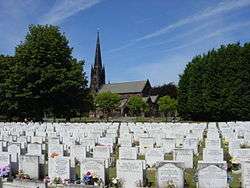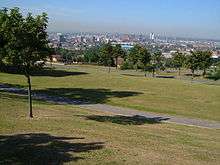Parks and open spaces in Liverpool
Liverpool, England, UK has a significant area of public parks and gardens. The English Heritage National Register of Historic Parks describes Merseyside’s Victorian Parks as collectively the "most important in the country".[1] The city of Liverpool has ten listed parks and cemeteries, including two Grade I and five Grade II*, more than any other English city apart from London.[2]
There are over 2,500 acres (10 km2) of parks and open spaces in the city.[3]
Much of the open space was for centuries private estate land. In particular several of the city's grand houses of the Georgian and Victorian eras are now either demolished or in public ownership, with their grounds and gardens given over to the city. Notable, however, are several parks which were conceived from the outset as public parks, modelled in part on the nearby Birkenhead Park, outwith Liverpool across the River Mersey, which was amongst the first of its type in the world.
Historical background
In 1833, the government's Select Committee on Public Walks emphasised the need to provide accessible space for recreation to improve the health of the urban population, to defuse social tensions and to allow social classes to mix.
From the early 1850s onwards, Liverpool endorsed this policy with the introduction of a ring of major municipal parks through a significant level of investment in public parks. These included Princes, Sefton, Wavertree, Shiel, Newsham and Stanley Parks.
Parks and open spaces
This list includes all the parks and open spaces included in the website of Liverpool City Council,[4] all the registered parks and gardens in the National Heritage List for England, and a historic park that is now closed.
Key
| Grade | Criteria[5] |
|---|---|
| I | Of exceptional interest |
| II* | Particularly important, of more than special interest |
| II | Of special interest, warranting every effort to preserve them |
| Name | Map ref and coordinates | Photograph | Size | Notes | Grading |
|---|---|---|---|---|---|
| Abercromby Square |  |
The square was built in about 1820 for Liverpool Corporation on heathland called Mosslake Fields. The design was by the Corporation surveyor, John Foster (senior). The buildings around the square are now occupied by the University of Liverpool.[6] | — | ||
| Allerton Cemetery |  |
34 hectares (84 acres) |
The cemetery opened in 1909 in part of the grounds of the Allerton Hall estate. It contains three sandstone chapels, all with steeples.[7][8] | II | |
| Allerton Tower Park | 14 hectares (35 acres) |
The park originated as the grounds of Allerton Tower, a house designed by Harvey Lonsdale Elmes and completed in 1849. Liverpool Corporation bought the house and grounds in 1924, and the house was demolished. The park now hosts an outdoors activity centre.[9][10][11] | — | ||
| Alt Meadows | 8 hectares (20 acres) |
The newest park in Liverpool, officially opened in March 2014.[12] | — | ||
| Anfield Cemetery |  |
57 hectares (140 acres) |
The cemetery was built in 1861–64 because those nearer the centre of the city were full. The layout was designed by Edward Kemp, and its buildings were mainly by the local cemetery architects Lucy and Littler. Two of the original three chapels have since been demolished.[13][14] | II* | |
| Belle Vale Park | This is a small park in a densely populated part of the city. Close to it is the Lee Valley Millennium Centre.[15] | — | |||
| Calderstones Park |  |
38 hectares (94 acres) |
The park has been developed from the grounds of Calderstones House, built in about 1828. The grounds were converted into a park in 1913, and the house is used as council offices.[16][17][18] | — | |
| Camphill and Woolton Woods | 30 hectares (74 acres) |
The park has been formed from the adjoining grounds of two houses, Camp Hill, which has been demolished, and Woolton Hall. It contains a walled garden and a floral cuckoo clock.[19][20] | — | ||
| Canalside Park | This is a small linear park lying between Vauxhall Road and the Leeds and Liverpool Canal.[21] | — | |||
| Childwall Woods | 16 hectares (40 acres) |
This formerly consisted of the grounds of Childwall House, which became a golf clubhouse in 1922. The house and grounds were acquired by the city council in 1939, and the house was demolished in 1949.[22][23] | — | ||
| Clarke Gardens | Named after the Clarke family who were the last owners of Allerton Hall and who gave the hall and grounds to the city council.[24] | — | |||
| Croxteth Country Park | 203 hectares (500 acres) |
This large country park surrounds Croxteth Hall, the former home of the Earls of Sefton. It contains a walled garden and a home farm, both of which are open to the public.[25][26][27][28] | II | ||
| Devonfield Garden | This is a small community park in a residential part of the city.[29] | — | |||
| Doric Park | The is a small community park in the Old Swan area.[30] | — | |||
| Everton Park |  |
The park was created in the early 1980s on Everton Hill, the highest point in the city. It contains a walled garden and two small lakes.[31][32] | — | ||
| Falkner Square |  |
This was one of the first public open spaces in Liverpool and was in existence by 1831. Building of the surrounding houses commenced in the 1840s.[33][34] | — | ||
| Greenbank Park |  |
The park contains a lake as its centrepiece, which can be used for fishing. It also has a children's playground, a walled garden, and it hosts a graffiti art project.[35] | — | ||
| Larkhill Park | Much of this small park is occupied by a pond, which can be used for fishing.[36] | — | |||
| Newsham Park |  |
48 hectares (120 acres) |
The park has been developed from the grounds of Newsham House, and was laid out by Edward Kemp. It contains two lakes, a bandstand, and play areas.[37][38][39] | II* | |
| Norris Green Park | |||||
| Otterspool Park | The park was developed from the grounds of the former Otterspool House. It has been a public park since 1932, and is adjacent to Otterspool Promenade.[40][41] | — | |||
| Princes Park | 28 hectares (69 acres) |
This was Liverpool's first public park, and was the first park designed by Joseph Paxton. It contains a fishing lake, and children's play areas.[42][43][44][45] | II* | ||
| Ranelagh Gardens | This was the first open space for public recreation in the city, opening in 1722. It closed in the late 1790s, and its site is now occupied by the Adelphi Hotel[46] | — | |||
| Reynolds Park | 6 hectares (15 acres) |
The park has been developed from the grounds of the former Reynolds Park Mansion that burnt down in 1921. It contains a walled garden, a wildflower meadow, a sunken garden, a topiary and a ha-ha.[47][48] | — | ||
| Sefton Park |  |
82 hectares (200 acres) |
This large park contains a Grade II* listed Palm House, the Shaftesbury memorial and Eros fountain, a Peter Pan statue, a grotto, a boating lake, a bandstand, and cafés.[49][50][51] | I | |
| Stanley Park | .jpg) |
46 hectares (110 acres) |
Laid out between 1867 and 1871, the park was designed by Edward Kemp. It contains the Isla Gladstone Conservatory, lakes, a bandstand and play areas.[52][53][54][55] | II* | |
| St James Gardens | 4 hectares (9.9 acres) |
Situated to the east of Liverpool Cathedral the gardens occupy a sunken site that was formerly a quarry, then a cemetery. Within the gardens is a memorial to William Huskisson.[56][57][58] | I | ||
| St John's Gardens |  |
Adjacent to St George's Hall in the centre of the city, the site was formerly occupied by a church. Opened in 1904 it contains formal gardens, statues to prominent men of Liverpool, and a memorial to King's Regiment (Liverpool).[59][60][61] | — | ||
| St Nicholas Church Gardens | The former churchyard of St Nicolas' Church was laid out as a garden in 1891. It contains a memorial to those who died in the Liverpool Blitz.[62][63] | — | |||
| Toxteth Park and Cemetery |  |
16 hectares (40 acres) |
This was the first cemetery in the Liverpool area to be created under the Burial Act of 1857. Two of its original three mortuary chapels remain.[64][65] | II | |
| Walton Hall Park | 52 hectares (130 acres) |
The park was developed in the grounds of Walton Hall, which was demolished in about 1918. It contains a fishing lake, a pool for sailing model boats, and a play area.[66][67] | — | ||
| Wavertree Botanic Garden and Park |  |
14.6 hectares (36 acres) |
Botanic gardens founded by William Roscoe opened in 1836 and were acquired by the Corporation in 1846. Ten years later the land to the south of the botanic gardens was laid out as a park. The glasshouses were destroyed in the Second World War. The walled garden is still present.[68][69][70][71] | II* | |
Entry to all of these parks is unrestricted in terms of opening hours, with the exception of the walled botanic garden in Wavertree Park; and free of charge in all cases.
Croxteth Country Park
- Main Article Croxteth Hall
Today Croxteth Hall & Country Park is managed by Liverpool City Council. This park is an example of a working country estate, with the park featuring the historic Hall itself, surrounded by mature woodlands, a collection of rare breed farm animals in the traditional "Home Farm" yard, and a Victorian walled garden. The Hall is Grade II* listed and the Park Grade II.[72]
Academic studies
Academics from the University of Liverpool's School of History have undertaken research on the historic development of parks and open spaces in the city and their future contribution to community development, education, bio-diversity, public health and urban regeneration. The team have worked to compile the first definitive chronology of the city’s parks over the past 200 years and a book should document the changing role of parks, from their prominence during the Victorian era through to the present day.[73]
References
- ↑ Dr. Peter Brown, chair, Merseyside Civic Society
- ↑ Liverpool City Council News, 23/2/2009
- ↑ "Parks and recreation". Liverpool City Council website. Retrieved April 23, 2007.
- ↑ Parks and greenspaces, retrieved 24 August 2011
- ↑ Grading, English Heritage, retrieved 1 June 2011
- ↑ Pollard & Pevsner 2006, pp. 368–369
- ↑ Pollard & Pevsner 2006, p. 387
- ↑ Historic England, "Allerton Cemetery (1001636)", National Heritage List for England, retrieved 2 September 2013
- ↑ Allerton Towers, Liverpool City Council, retrieved 23 May 2011
- ↑ Pollard & Pevsner 2006, pp. 391.
- ↑ Twist 2000, pp. 37–38
- ↑ Mayor officially opens new Alt Meadows park in Liverpool
- ↑ Historic England, "Anfield Cemetery (1000993)", National Heritage List for England, retrieved 2 September 2013
- ↑ Pollard & Pevsner 2006, pp. 394–395
- ↑ Belle Vale Park, Liverpool City Council, retrieved 23 May 2011
- ↑ Calderstones Park, Liverpool City Council, retrieved 23 May 2011
- ↑ Pollard & Pevsner 2006, pp. 389.
- ↑ Twist 2000, pp. 29–33
- ↑ Camphill and Woolton Woods, Liverpool City Council, retrieved 23 May 2011
- ↑ Twist 2000, pp. 34–36, 42–43
- ↑ Canalside Park, Liverpool City Council, retrieved 23 May 2011
- ↑ Childwall Woods, Liverpool City Council, retrieved 23 May 2011
- ↑ Twist 2000, pp. 55–58
- ↑ Twist 2000, pp. 44–45
- ↑ Croxteth Country Park, Liverpool City Council, retrieved 23 May 2011
- ↑ Pollard & Pevsner 2006, pp. 406–409.
- ↑ Twist 2000, pp. 62–63
- ↑ Historic England, "Croxteth Hall (1001304)", National Heritage List for England, retrieved 2 September 2013
- ↑ Devonfield Gardens, Liverpool City Council, retrieved 23 May 2011
- ↑ Doric Park, Liverpool City Council, retrieved 23 May 2011
- ↑ Everton Park, Liverpool City Council, retrieved 23 May 2011
- ↑ Twist 2000, pp. 59–61
- ↑ Falkner Square, Liverpool City Council, retrieved 23 May 2011
- ↑ Pollard & Pevsner 2006, pp. 374
- ↑ Greenbank Park, Liverpool City Council, retrieved 23 May 2011
- ↑ Larkhill Park, Liverpool City Council, retrieved 23 May 2011
- ↑ Newsham Park, Liverpool City Council, retrieved 23 May 2011
- ↑ Historic England, "Newsham Park (1001536)", National Heritage List for England, retrieved 2 September 2013
- ↑ Twist 2000, pp. 17–19
- ↑ Otterspool Park, Liverpool City Council, retrieved 23 May 2011
- ↑ Twist 2000, pp. 49–52
- ↑ Princes Park, Liverpool City Council, retrieved 23 May 2011
- ↑ Historic England, "Prince's Park, Liverpool (1000998)", National Heritage List for England, retrieved 2 September 2013
- ↑ Pollard & Pevsner 2006, pp. 451–453
- ↑ Twist 2000, pp. 14–16
- ↑ Layton-Jones & Lee 2008, pp. 4–6.
- ↑ Reynolds Park, Liverpool City Council, retrieved 23 May 2011
- ↑ Twist 2000, pp. 46–48
- ↑ Sefton Park, Liverpool City Council, retrieved 23 May 2011
- ↑ Historic England, "Sefton Park, Liverpool (1000999)", National Heritage List for England, retrieved 2 September 2013
- ↑ Twist 2000, pp. 24–28
- ↑ Stanley Park, Liverpool City Council, retrieved 23 May 2011
- ↑ Historic England, "Stanley Park, Liverpool (1001000)", National Heritage List for England, retrieved 2 September 2013
- ↑ Pollard & Pevsner 2006, pp. 395–397
- ↑ Twist 2000, pp. 20–23
- ↑ St James Gardens, Liverpool City Council, retrieved 23 May 2011
- ↑ Twist 2000, pp. 2–5
- ↑ Historic England, "St James's Cemetery, Liverpool (1001585)", National Heritage List for England, retrieved 2 September 2013
- ↑ St Johns Gardens, Liverpool City Council, retrieved 23 May 2011
- ↑ Pollard & Pevsner 2006, pp. 335
- ↑ Twist 2000, p. 66
- ↑ St Nicholas Church Gardens, Liverpool City Council, retrieved 23 May 2011
- ↑ Pollard & Pevsner 2006, pp. 284
- ↑ Historic England, "Toxteth Park and Cemetery, Liverpool (1001611)", National Heritage List for England, retrieved 2 September 2013
- ↑ Pollard & Pevsner 2006, pp. 474
- ↑ Walton Hall Park, Liverpool City Council, retrieved 23 May 2011
- ↑ Twist 2000, pp. 53–54
- ↑ Wavertree Botanic Garden and Park, Liverpool City Council, retrieved 23 May 2011
- ↑ Historic England, "Wavertree Botanic Garden and Park (1001538)", National Heritage List for England, retrieved 2 September 2013
- ↑ Pollard & Pevsner 2006, pp. 413
- ↑ Twist 2000, pp. 9–13
- ↑ English Heritage Register
- ↑ "Researchers explore history of Liverpool parks". University of Liverpool. Retrieved April 23, 2007.
- Bibliography
- Layton-Jones, Katy; Lee, Robert (2008), Places of Health and Amusement, Swindon: English Heritage, ISBN 978-1-873592-91-5
- Pollard, Richard; Pevsner, Nikolaus (2006), Lancashire: Liverpool and the South-West, The Buildings of England, New Haven and London: Yale University Press, ISBN 0-300-10910-5
- Twist, Colin (2000), A History of Liverpool Parks, Southport: Hobby Publications, ISBN 1-872839-06-1
